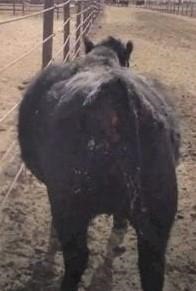By Jerad Jaborek
Bloat is a digestive disorder that results from the accumulation of excessive gas within the rumen and can lead to death of the animal by asphyxiation. Gases such as carbon dioxide and methane are normal by-products produced during microbial fermentation of feed stuffs. The gases produced in the rumen can either be absorbed through the rumen wall, travel through reticulum and the remaining digestive tract, or predominately, they are eructated or belched out through the esophagus. Eructation of gas from the rumen through the esophagus is done by a series of muscular contractions that is initiated by the accumulation of gas within the rumen to signal for its release. However, proper rumen function and motility can be impaired by large amounts of acids produced during ruminal fermentation. If normal rumen contractions are prevented or if the esophagus is obstructed, bloat can occur.

An example of an animal with a severe case of bloat from a Veterinary Clinics: Food Animal Practice article by Meyer and Bryant.
According to an article from the Journal of Animal Science by Cheng and others, there are two types of bloat: free-gas bloat or frothy bloat. Free-gas bloat can occur when the esophagus becomes obstructed by incompletely processed or chewed feeds (e.g., potatoes, beets, apples, turnips) and even hay twine. Free-gas bloat can also be caused by a lack of rumen motility, which can be caused by damage to the vagus nerve by pneumonia, hardware disease, or thoracic abscesses. Additionally, rumen motility can be impaired by the onset of acidosis, and hypocalcemia. Frothy bloat develops when a stable foam forms in the rumen and traps gases in the rumen liquid phase, preventing the separation of rumen feed particles and liquids from the gas within the rumen. As the rumen fills from increased digesta and gas accumulation, frothy foam formation can obstruct the esophagus from allowing gases to be belched from the rumen, thus causing the animal to bloat.
Signs of bloat
During the onset of bloat, the left paralumbar fossa (triangular area between the last rib and hook bone) becomes distended. As the severity of bloat progresses, the distention of the paralumbar fossa will become more obvious, the rectum may begin to protrude from the animal, and pressure on the diaphragm may cause the animal to have difficulty breathing and be unwilling to move according to a Veterinary Clinics: Food Animal Practice article by Meyer and Bryant.
Treatment of bloat
According to an Alberta Agriculture and Rural Development publication by Majak and others, a large diameter hose or tube (0.75 inch diameter, or a standard garden hose) can be placed in the animal’s mouth, allowing them to swallow it so it passes through the esophagus and into the rumen. Be careful not to place the hose or tube in the lungs. Make sure the hose or tube is cleared and move it back and forth to reach different areas of the rumen. If gas does not appear to be escaping the rumen from the hose or tube, remove the hose or tube and check the end for froth. For treatment of frothy bloat, non-toxic oils, such as a mineral or vegetable oils, can be administered at a rate of 1.0 to 1.2 oz./100 lb. of body weight into the rumen via a stomach tube or drench. In severe cases of bloat, surgical intervention may be needed. Contact your veterinarian, as a rumenotomy may need to be performed or a trocar and cannula may need to be inserted into the paralumbar fossa to relieve gas from the rumen.
Bloat Prevention
Acidosis and bloat can be interrelated, with acidosis predisposing animals to bloat. Using management practices that consider the proper amount of grain and roughage in the diet, proper grain selection and processing, use of proper bunk management, use of feed additives, and allowing adequate time between diet transitions can help to limit the occurrence of acidotic bouts in feedlot cattle. Furthermore, proper forage species selection and grazing management practices will help to prevent pasture bloat in grazing cattle.
The fermentation of grains in the rumen leads to the production of volatile fatty acids (VFA) for energy use in ruminants. Greater VFA production and absorption typically results in the greatest body weight gains. However, if VFA production is too rapid, rumen pH and rumen motility can decrease, leading to acidosis and bloat. Consider managing the amount of feed offered and possible programmed intake strategies to prevent binge eating events by animals. Starch fermentation from grains is more rapid for smaller grains (oats, barely, rye) and from finely processed grains. Make sure to provide enough roughage or fiber in the diet. Most finishing rations fed to feedlot cattle contain 10 to 15% roughage. Also allow adequate time for cattle to adapt to consuming high-grain diets. Increase the amount of grain within the diet slowly over the course of a couple weeks and refrain from making large changes in the amount of feed offered. Additionally, the inclusion of ionophores, such as Rumensin and Bovatec, in the diet have been shown to decrease the incidence of bloat.
Grazing alfalfa, red clover, white clover, sweet clover, and winter wheat have a greater chance of causing frothy bloat. Additionally, bloat is more common when these previously mentioned forages are consumed at earlier growth stages. Therefore, consider appropriate forages for pasture mixes and grazing management practices to avoid pasture bloat.
In summary, there are two types of bloat, free-gas bloat and frothy bloat, that cause the build of gas within the rumen and can ultimately lead to death by asphyxiation. Sometimes subtle or unnoticeable changes in cattle feed intake, feed management, grain processing, pasture growth, and weather changes can cause bloat to occur. Remember to keep a careful watch for signs of bloated animals and be prepared to treat bloated animals quickly when bloat occurs.
Source : osu.edu